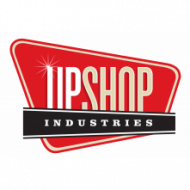Upcycling is thinking about waste, about what it actually is, and how we are all responsible for it.
Visitors to the second UpShop market could have exchanged a nut (as in nuts and bolts!) for a flat white and perhaps, purchased some of the materials stored in the workshop or one of the strange and curious objects rescued from landfill.
And, they could have purchased upcycled goods, too. From Cath, who runs Wozwaste Cath works with a variety of materials that are rescued from landfill – soda bottles, toothbrushes, empty toothpaste tubes, and the inner tubes from tyres. And from what was waste emerges many beautiful and useful products: inner tubes, for instance, become bags, wristbands, backpacks, belts, guitar straps, earrings, satchels…
We appreciated the stitching on each wallet and the weight of the butyl rubber from which they are created. Each item felt durable, yet light; retaining the unique traces of the individual who made it. There are different designs for the wristbands; each shape is cut into the rubber using a hammer and a “plong”. You can still see the different textures and markings of the particular inner tyre that was sourced for the wristband.
The amount of tyres headed for landfill is staggering. In 2016, TyreStewardship Australia reported that 48 million tyres reached landfill each year in Australia. In 2022, Australia generates an average of 459,000 tonnes of waste tyres annually and we manage to recover 70% from landfill with the implementation of the Tyre Product Stewardship Scheme.
This process of recovery involves upcycling: that is, if you see upcycling in the same way as the writer on Intercon proposes: as a “process that can be repeated in perpetuity of returning materials back to a pliable, usable form without degradation to their latent value—moving resources back up the supply chain”. Rubber granulate and crumb is traditionally produced by a mechanical process of shredding or grinding, with new processes like cryogenic processing where the tires are ground at temperatures minus 80 degrees Celsius. This granulated material is then manufactured into other products such as shoe soles and brake pads, and is used to resurface roads. This process of upcycling – at the level of manufacturing does reduce energy consumption and remove the material from the waste stream.
But, it just means the whole problem of this waste-material just disappears. When you are driving along a road resurfaced with rubber crumb, do you think “This used to be tyres?” or “what actually happens to my tyres when they wear out and I replace them with new ones”?
Probably not.
Being able to touch this material that’s been remade made us curious about the material itself – butyl rubber. Search for ‘butyl rubber’ on Google, you will discover a lot of chemistry speak, and that it’s a pervasive and perplexing material. Chewing gum is made from “polyisobutylene”: that’s what makes it chewy and why it sticks to everything including the street. Even chewing gum is a problem of waste disposal (despite efforts to market a more biodegradable version since Revolymer patented Rev7 in 2010).
Butyl rubber is used in the seals in gas masks and protective garments because it’s the most impervious to chemical warfare agents and decontamination materials. Imagine chemical warfare and military personnel sweating inside a breathing apparatus with a full-body suit of cross-linked butyl rubber – or not as sweaty if they are wearing suits improved by blending butyl rubber with liquid crystals that could be organized to form hydrophilic, 1.2-nanometer-wide pores (for a taste of the chemistry speak).
And butyl rubber meant we could go to the Moon. The NASA Apollo-era SCAPE suit Toxic Fuel Handler’s coveralls was actually a set of butyl-rubber coveralls with helmet, no gloves or boots, and was worn by those who had to transfer the dangerously volatile and corrosive propellant fuel to and from rockets at the Kennedy Space Center during the Apollo era. Ironic, really, that the same material that produces palls of thick, toxic smoke when stockpiled tyres catch fire is used to protect us of from its hazardous effects…
But when waste is remade like what Cath does, when it’s upcycled, it can be seen *as a problem*. Upcycling makes sure that waste can’t just disappear. Our lovely barista-for-the-day, Elena is a perfect model. Wearing the satchel, earrings, wallet and wristband that Elena purchased from Kath, Elena looks beautiful and she draws our attention to the problem of waste – and that we need to take responsibility for it.
On the wozwaste website, Cath talks about the ethos of her enterprise and says: “that it is possible to run a business with integrity, that has a positive effect on all those involved in it (craftspeople thru to consumer) including this amazing planet earth that we all share”. Cath not only designs products that upcycle waste and works with others to do so, she also travels around Australia to festivals, keeping what was once waste visible within our lives so that we keep curious about what waste is, and how we can re-make it.




